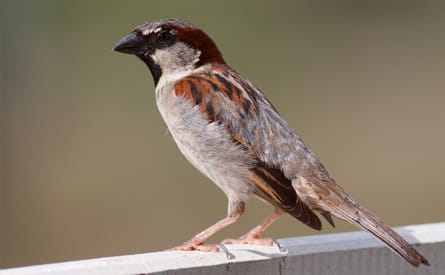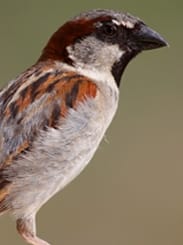
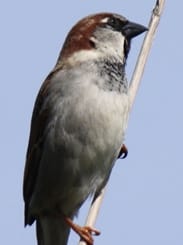
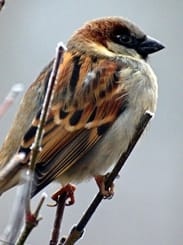
Sparrow (Passer Domesticus)
Proving date: 2004
Proving completed by: Misha Norland, Peter Fraser & The School of Homeopathy
Common name : Sparrow
Download: Full proving Sparrow (Passer Domesticus)
Download: Proving rubrics
About the Sparrow
Nobility and greatness vs crushed, accused and punished. Defiant, pugnacious and fizzing energy.
Pugnacious and confrontational sums up the personality of this patient, which is coupled with a hyperactive energy that is buzzing, fizzing, restless and watchful. There is a teenage quality even in the older patient. They like to flock together, are competitive, fast drivers, with argumentative and defiant energy, and powerful sexuality. They love clothes and colour. They feel they are totally irresistible, which can of course call up challengers, and they are not afraid to fight, even to the death. They like to be homemakers – the thrust in their lives is to find the right partner and to create the best possible home. Top of the list, though, is this patient’s sensitivity to being dishonoured. The feeling of being under attack and undervalued is as strong as is their violent reaction. 'I can stand up for myself and shall not be bullied!' Dominant themes include being disrespected and dishonoured, hounded out, and killed. The opposite themes are victory over injustice leading to feeling accepted, and honoured.
Sparrow
Passer domesticus is part of a small family of birds called passerine birds, Passeridae. Sparrows are generally small brown-grey birds with short tails and small powerful beaks. The sparrow is primarily a seed eater but also consumes small insects. They have specialised bills and elongated alimentary canals for consuming and digesting seeds. They are descendants of old world weaver finches, a family of birds distinguished for their resourceful nest-building ability.
House sparrows have long adapted to human habitations. They seek company of their own kind and also that of humans, nesting close by to find food. They dart about in large groups, chirping, playing, feeding together, and have sand and water baths en masse. The sparrow is often regarded as one of the most lustful and sexually active of birds. The male sparrow builds a nest and the female chooses her mate on the quality of the home he has to offer. However, in recent times when there have been food and nesting site shortages, it has been noticed that the females have become increasingly polygamous; they will mate with the strongest males around and then return to their nice home. The male sparrow will guard its nest with all its might, and fights between young males are bloody and often fatal.
Mythology
Symbol of love: House sparrows are mentioned in classical Greek mythology where they are associated with Aphrodite, the goddess of love. In a poem by Catallus (born c. 84 bc), Lesbia's sparrow is a symbol of divine and enduring love, 'Mourn oh Venuses and Cupids and all men who are acquainted with love. My girl's sparrow has died; the sparrow, delight of my girl, whom she loved more than her own eyes'.
History
Christianity: In the Bible, we are taught that the sparrow is a significant little bird and despite having little value, it is a symbol of worth. The sparrow was so widely respected that if you bought 4 of them the seller would throw in one more for free. It was this extra sparrow of which Jesus said, 'And not one of them is forgotten before God.' The care of God's creation was so great that even the extra sparrow was observed by God. The thought behind this was that if God is concerned about the tiny sparrow and his fate, then how much greater must his concern be for mankind, that is immeasurably greater in value than the sparrow. Sparrows are social creatures thus a solitary sparrow was seen as the symbol of deep loneliness: ‘I lie awake; I am like a lonely sparrow on the housetop’ (Psalm 102:7). Saint Francis expressed his love for all God's creatures by preaching his sermons to sparrows. The sparrow was the only bird present throughout the crucifixion of Christ, making it a symbol of fidelity and spiritual connection, and echoing its Ancient Greek association with the beloved. For Christians, the enduring beloved is the saviour, Jesus Christ.
Medieval times: The sparrow was a household deity in the UK and, in medieval times, it was an emblem of peasants and the lower classes in Europe; a symbol of victory over injustice. Peasants were invariably beholden to, and downtrodden by, their overlords. To compensate for this imbalance in power, they created stories about the insignificant sparrow dominating potent enemies, such as wolves, bears, and eagles, which were the traditional symbols of nobility and those who subjugated the peasants.
Cockney folk: London's indigenous working class population – the Cockneys – adopted the sparrow as their emblem on account of the bird's gregarious nature, their love of chattering and extended families, which allowed for squabbling, and reconciliation. Working class children were always in and out of each other’s homes, ganging up and, of course, fighting off rivals. This behaviour is seen in sparrows too, for they are amongst the most social birds who will however, relentlessly defend their nesting sites.
'Pests': It is easy to access material about the sparrow on the Internet. Such a search furnishes a plethora of information about killing these 'pests', for that is what they have become in many countries where they have been inadvertently or foolishly introduced. In the USA and in NZ for instance, they have become a threat because they push out indigenous species.
Demise of the sparrow: Misha Norland writes, 'Recently, upon learning of the general decline, and in many major cities the total disappearance of house sparrows, most of us in the UK felt shocked and saddened by the demise of our once-familiar friends. But around Yondercott, my old house in rural Devon, with its ivy clad north-facing wall providing ample nesting sites, and duck and chicken food to pilfer, sparrows abounded. That is, until the sparrow hawk took up residence in the garden to raise its young. The sparrows were temporarily decimated, only to multiply again, so that by Christmas, they were full-throated and chirping to celebrate their own and our family's reunion. I had long cherished the desire to carry out a proving of this noisy little bird, so ubiquitous as to be taken for granted in our disenchanted modern times, so successfully adapted to our human environment and so honoured in past ages when the significance of totem and symbol was regarded. How wonderful that a bird should voluntarily decide to take up an environmental niche provided by us without being trained for it, as are hawks and falcons, without being encouraged by providing special sites, as are doves or set bird tables and feeders to entice them, without being domesticated as are cats and dogs. In fact, 'how wonderful' sums up what many of us feel about this cheeky and chirpy familiar bird. And how different this is to our attitude towards other creatures who live amongst us as pests, as do rats and cockroaches. Perhaps our love affair with 'a common bird of the people' is turning sour as we wrestle to climb out of working class status, aspiring, upwardly mobile, towards being closer to the ruler rather than the ruled. In many environments, house sparrows are becoming an endangered species.'
Passer domesticus, House sparrow
They love us; do we love them?
Sparrows are rabble under eaves. Drab of feather,
breeding fast, flying in flurries, leaves in draft,
they chirp but cannot sing, just a common thing
working folk have an affinity for. Sparrows provide
fast-food for cat, target practice for brat, not much more.
Living amongst us, you’d imagine they’d be our pride!
Do you think Saint Francis taught them humility?
Perhaps they offer us mirrors in which to see
things we do not wish to view. We make small-talk,
but when do we feel simply beautiful and true?
When do we chirp, 'You see me. I see you?'
The proving
The first group of symptoms in the remedy included a sense of restless energy that links to the energetic, boisterous and fidgety nature of the bird. Provers felt energised but there was also a polarity of becoming bored – a chattering boredom in which the provers were talkative and communicative – and a tendency to irritation. One prover described this experience, saying, 'Visited a friend, but felt restless after half an hour, so I left,' and another who wrote, 'I have no attention or time for the benign. I feel socially irritable.'
In common with almost all the bird remedies, there was a sense of trance-like calm, peacefulness and an ability to remove oneself from the World and its turbulence. Accompanying this relaxed state was mental fog, being accident-prone and clumsy, and making mistakes whilst writing. For some provers, these symptoms created a sense of separation, which was recorded by one prover as,
'I feel very spaced out and detached all day, like there is a vague mental fog, which is almost visual, separating me from everything around me. It is hard to concentrate on the lecture even though I am very interested in what the tutor is saying and I am making a lot of mistakes while writing notes, particularly getting letters in the wrong order in words I know how to spell.'
There was a particular impression of growing old with provers reflecting on their lives, which contradicts the youthful exuberance of the bird. Sex and mating was a central issue for many provers and there was also a distinct feminine element in the proving – 'I felt a need to be more feminine and softer, had my hair cut but kept it longer, and wanted to wear long earrings today.' The desire for family and the safety of the familial environment was strong. Nesting emerged in the proving, with provers wanting to cook and provide food for friends and family, with a buzzing energy for some. One prover wrote, 'I feel really lively and want to be doing something! I need to be active. I feel happy helping to prepare the veg for dinner, I feel very sociable, bit excitable'. There was an affinity to the mouth. Appetite was generally diminished and there was a general aversion to food, especially heavy and fatty foods.
Being honoured, respected and valued for their honesty, were important for many provers – 'A feeling that I am the King of all I survey' – and these essences were also evident in their dreams. Violence was striking in the remedy, with a sense of being threatened and the victim of violence, that was experienced by many provers, as was swearing and aggressive behaviour. An interesting aspect of the proving was an association with cats. The School cat spent almost all the proving weekends firmly planted on the lap of one the provers, which was unusual. Many provers found that their relationships with cats was altered during the proving, and many provers had dreams of cats and dogs, but especially of cats. The connection between predator and prey is important in Bird remedies, so it was revealing that provers had a strong sense of identification with cats, which are the sparrow's most ruthless predator. However, sparrows have acute senses and, due to their colouring, are well-camouflaged from a cat’s keen sight.
The sparrow as one prover put it, has access to ‘a deep spiritual connection with life as a never ending experience’ and, along with the sparrow's passion and energy, it beckons us to keep our burdens light so that we may avoid carrying a heavy melancholic heart. One prover described this as, 'a light, euphoric sensation, pulling up from the top of my head. I am connected to the Spirit world.' This reflects innate self-worth and the right to be who we are. The sparrow's persistence and integrity shows us that we do not have to be big to make a difference.
Download: Full provingSparrow (Passer Domesticus)
Download: Proving rubrics
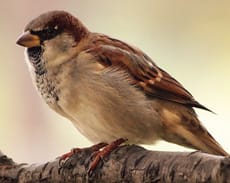
Chattering boredom - Acute senses - Trance-like - Growing old - Melancholic - Mental fog - Mating - Feminine - Nesting - Cats - Swearing - Honoured
Proving Themes
Kingdom : Animalia
Phylum : Chordata
Clade : Dinosauria
Class : Aves
Order : Passeriformes
Suborder : Passeri
Infraorder : Passerida
Superfamily : Passeroidea
Family : Passeridae : Illiger, 1811
Kingdom Taxonomy
Sparrows are one of the most sociable birds. They like to nest close together, congregate together and play together. Not only do they like the company of their own kind but they seem to really like the company of humans. They like their nests to be as close as possible to human habitations, it is possible that they feel some sort of protection from the presence of humans, many of their predators are afraid of man and so it is safer to be near human habitation.

.jpg)
